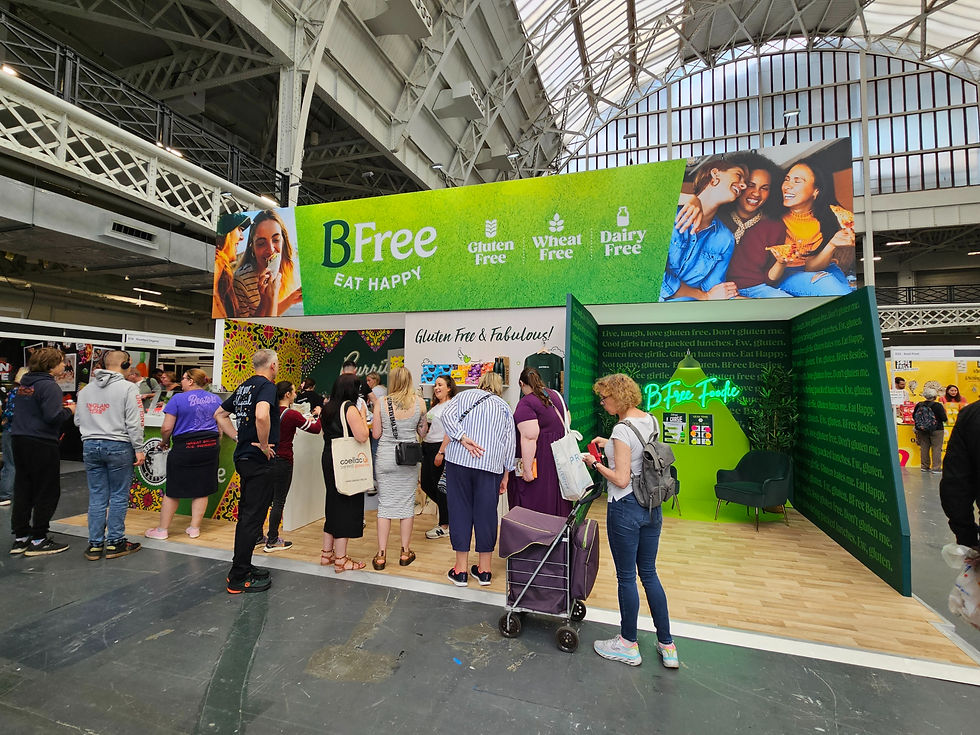Why live events still matter in 'modern' marketing
- Eleanor Loveday

- Apr 7
- 4 min read
Updated: Apr 8
In an age where digital dominates, more ‘traditional’ marketing channels like live events might seem dusty and outdated. Yes, they start at a higher price tag and take a lot of legwork. And no, they don’t come with the complex dashboards of digital channels. Instead, they bring their own unique benefits, which can build on the efforts of your entire marketing mix (including digital channels). The mighty event is far from outdated, and within an ‘experience economy’ live events matter more than ever, especially in ‘modern’ marketing.
Events in an Experience Economy
We won’t pretend the term ‘experience economy’ is anything radically new. It’s been bouncing about for some time, but was made popular by a book of the same name, by Joseph Pine and James Gilmore.
‘Experience economy’ refers to the increasing value that consumers are placing on experiences. From the top end of the spectrum (think Disneyland) to the smaller treats (walking into your local coffee shop, smelling freshly ground beans, watching the barista handcraft your coffee and writing your name on the cup…).
Perhaps it’s an antidote to our constantly digitised lives, or the continued after-effects of being cooped up during the pandemic, but real-life experiences are something we’re craving more than ever. People want memorable experiences in the everyday, and they’re happy to pay for it.
We can see it in the resurgence that events have made in the past 3 years. Visitor numbers on events are up, new venues are opening, and experiential pop-ups are a common sight on the daily around large cities.
Live. Events. Slow. People. Down.
The digital world is oversaturated with content, and every day consumers are bombarded with thousands of notifications, ads, emails, you name it. Meanwhile, live events slow people down and offer brands a chance to grab attention – whether it’s through a guerrilla activation or an exhibition stand at a trade show. And once you’ve got their attention, you can focus on delivering an impactful and memorable experience for your guests.
Engagement is key, but it doesn’t have to be measured in click-through rates and likes.
Someone playing hopscotch between 100 open tabs in the office, or doomscrolling on their phone, might not be that engaged in your brand’s message. But someone chosen to attend an event, taken time out for it, travelled, paid for a hotel, and ironed their crispest shirt – hopefully more so. They’ll probably also be more engaged than someone attending a virtual event – after all, there’s more distractions when you’re sat in your living room, the dog is barking, and Outlook is winking at you from the corner of the screen.
Plus, there’s so many creative ways you engage with your audience in-person. From games to quirky brand interactions, you can create experiences that entertain, educate, or inspire guests, boosting brand salience as a result.
More connection, more energy
Clever brand interactions and tech-driven games are all well and good. But strip them away, and at the core you’ll find the thing that engages people best. Conversation. Real, live, person-to-person conversation. Have you ever had a really good chat with someone and it’s left you feeling energised, motivated, inspired, excited…? (If you’re an introvert, we’ll let you off, this might not be your scene) Conversations carry energy, and a good one should give you energy, too.
It comes back to the old saying of ‘people buy from people’. Relationships are important, particularly in B2B markets, and there’s no better way of growing them than in-person.
Keeping it authentic
People don’t want to feel like marketing is marketing. Riding a tidal wave of ad messaging every day, consumers will see through any BS instantly and suss out overly polished brand comms or influencer marketing that isn’t genuine. In fact, a 2021 report from Stackla found that since the pandemic, 88% of consumers view authenticity as important in their consumption choices. Having a real conversation can give prospective clients a much better idea of what your brand stands for and whether it aligns with their values, than any type of digital comms.
It all comes back to experience
Live events bring a juicy stack of benefits to the table. They put you in the room directly with an engaged and attentive target audience. They can get product physically into the hand of the consumer, as well as giving brands the chance to bring an intangible product or service to life. Relationships and brand loyalty are built at events. They have a positive impact on every stage of the funnel, from awareness to advocacy.
And it all comes back to experience, made up of sensory interactions, good conversation, and memorable moments. Leaning into what makes live events live means pushing further up the value chain and giving guests more to think and remember about your brand.
It’s something that just can’t be found in other marketing channels. And because it’s something consumers are actively seeking? Even better.
We don’t believe in the ‘traditional vs digital’ argument, and we’re not disputing that digital channels have benefits events don’t. But it doesn’t have to be one or the other. It can (and should) be both. After all, a multichannel mix is always best.
Embracing live events as a valuable part of that mix will unlock a whole host of unique brand benefits, perks which are not to be underestimated.
So, it's not just that live events still matter. In ‘modern’ marketing, they’ve never mattered more.




















Comments